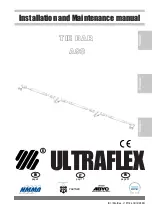
3. Remove the seat ring (key 15) from the body with
a socket wrench.
4. Clean the body threads of old sealing compound
using a wire brush.
5. Apply new sealing compound (high-pressure, high-
temperature sealant) sparingly to the threads and
shoulder of the new seat ring. Let stand until tacky
before assembling into the pilot body.
6. Lap in joint between new stem (key 22) and disk
(key 24).
7. Apply lapping compound to the disk, place it on
the stem and secure with a stem nut (key 25). Slip
the stem into it’s normal position and lap the disk
to seat joint.
8. Screw on the pusher plate (key 41), omitting the
valve spring. Hold the disk on the seat and adjust
the pusher plate until dimension (C=11/64 in. /
4.37 mm) is obtained. See Figure 5).
9. Remove stem nut, being careful not to disturb the
pusher plate adjustment and lift stem out the top
of the pilot. Grind off stem projection B flush with
upper surface of pusher plate.
10. Reinsert stem in the pilot with disk and a stem
nut attached. Check dimension c and, if correct,
lock the position by prick punching the thread at
several points. Work carefully to avoid bending the
stem.
11. Scrape away burrs raised by prick punching.
Upper surface must be smooth and flat.
12. Check that valve travel is A=3/64 in. / 1.19 mm.
This need not be exact. Stem should move
smoothly. Binding indicates a bent stem.
13. Remove stem nut and disk and withdraw stem.
Install stem with valve spring, disk and both stem
nuts in place.
Thermostat Replacement
To replace thermostat, proceed as follows:
1. Cool the thermostat bulbs of original and
replacement elements below the low end of their
temperature range (See range tag on flexible
tubing). Maintain bulbs at this temperature during
replacement process.
2. Back off temperature adjusting wheel (key 14)
to within a turn or two of the barrel nut (key 1).
Back off pressure adjusting screw (key 20) to
remove all compression from spring. This will allow
temperature diaphragm plate (key 7) to remain
seated in correct alignment on balls (key 10) after
disengagement of thermostat assembly. Unless
pilot is upright, balls will fall out of position.
3. Remove diaphragm nuts (key 8) and detach
thermostat assembly from pilot. Similarly, detach
shipping plate from replacement thermostat. When
removing diaphragm nuts, be sure cowl assembly
(key 29) does not turn in threaded joint at barrel
nut (key 1). If movement is observed, reset
position as per instructions for temperature stem
position adjustment.
4. Install replacement thermostat on pilot and install
shipping plate on original thermostat. Tighten
bolts evenly.
Temperature Adjustment
The temperature stem adjustment is factory set
and locked by a barrel nut (key 1). If the setting is
accidentally disturbed, readjust as follows:
1. Remove thermostat assembly per
instructions in Thermostat Replacement section.
2. Clamp a flat bar to the cowl (key 29) so that the
pressure plate (key 7) is flush with the cowl’s
pinch ring.
3. Loosen cowl bracket set screw (key 30) and
turn cowl assembly (key 29) up about one turn.
Remove putty from barrel nut set screw (key 1),
loosen set screw and back off barrel nut about
one turn.
4. Crack inlet stop valve or apply shop air to the pilot
inlet. Turn up pressure adjusting screw (key 20)
until flow issues from pilot outlet tee. Rotate the
cowl assembly (key 29) down until flow stops.
5. Lock this adjustment with the cowl bracket’s set
screw (key 30). Turn down the barrel nut (key 1)
to jam against cowl bracket and lock with it’s set
screw (key 5).
6. Reinstall the thermostat assembly.
7
Types T124 and T134






























